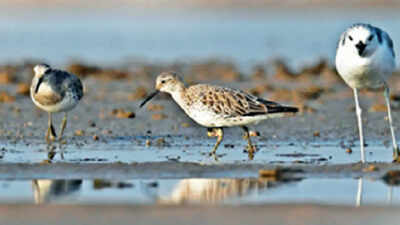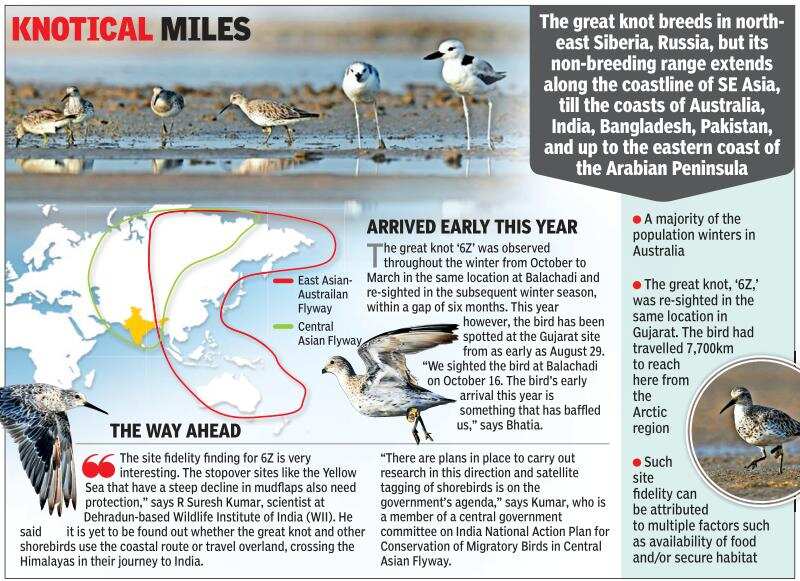- News
- City News
- ahmedabad News
- Knot ‘6Z’: From Russia with love

Re-sightings of the shorebird for three consecutive migratory seasons may be a strong sign of Balachadi being a favoured wintering ground for these birds
AHMEDABAD: Gujarat’s birdwatchers had reason to cheer when for the third year in a row, a great knot (Calidris tenuirostris), a shorebird tagged in Russia and code-named ‘6Z’, returned to the coastal village of Balachadi in Jamnagar district.
Re-sightings of the shorebird for three consecutive migratory seasons may be a strong sign of Balachadi being a favoured wintering ground for these birds. Many experts now hope that Gujarat and India’s long coastline will provide a safe haven for the waders amid their habitat loss in China and Africa.

"The great knot uses both the Central Asia Flyway (CAF) and the East Asian-Australasian Flyway (EAAF) for migration. Due to depleting mudflats in parts of China, there is a hypothesis that an increasing number of shorebirds could be using the CAF over EAAF," said Dishant Parasharya, an ornithologist working with Bombay Natural History Society (BNHS). The intertidal mudflats provide critical habitats for shorebirds for roosting and foraging. Parasharya said much research needs to be done on both the flyways before one can arrive at any strong conclusion.
The CAF covers a large continental area of Eurasia between the Arctic Ocean and Indian Ocean and the associated island chains. The EAAF is the name given to the route flown annually by Australia’s migratory shorebirds to and from their breeding grounds above the Arctic Circle in Alaska and Siberia, and it extends from Arctic Russia and North America to New Zealand.
The re-sighting of the 6Z for three successive migratory seasons lays to rest any doubts about Balachadi being only a stopover site for this bird. An iconic bird among waders, the great knot is a species of concern amongst the shorebirds. The International Union for Conservation of Nature (IUCN) status of the species has been revised from that of ‘Least Concern’ in 2014 to Endangered in 2019. It has been identified among Top 20 priority species for conservation in the Central Asian Flyway for India according to the National Action Plan (2018).
Tagged in Kamchatka
he large-scale loss and degradation of important resting habitats along their migratory journey, notably at the Yellow Sea in China, is widely thought to be driving the general population decrease in migratory shorebirds and especially in great knots, says Yashodhan Bhatia, an avid birdwatcher who spotted the ‘6Z’, and who along with Ashish Pankhania had visited the intertidal area of Balachadi coast on October 6, 2019 when they had first spotted the bird.
The duo was photographing and observing flocks of waders where they spotted around 20 great knots in a mixed flock that also had bar-tailed godwits. They were surprised to find a leg band on one of the great knots. "On further observation and after some more clicks, we noticed that there were two leg flags on the tibia of the left leg of the bird. A black flag without any number was placed over a yellow band which had ‘6Z’ engraved on it in black. A metal ring on the right leg was also visible," says Bhatia.
Through a shorebird tagging protocol chart, they concluded it might be a bird tagged in Russia. With the help of BNHS, the duo mailed photographs to researchers working in Russia and East Asia. They received a message from one Dmitry Dorofeev that this individual had been tagged in Kamchatka in far Eastern Russia by him on July 17, 2019.
Habitat threat from nearby ship-breaking yard?
The frequent occurrence of globally endangered species on the west coast of the country evidently proves the importance of the suitable habitat conditions for the species here.
Bhatia says that in the past, the great knot was documented in detail from southern parts of India with its population, status and other data. However, from the west coast, the reports have increased significantly for the last one decade.
Last year, another great knot, with a green over orange band on its right tibia was sighted at Akshi Beach near Mumbai. It was probably tagged in August 2020 at Yalujiang, China.
"There are sporadic reports that show that the bird is increasingly moving westwards rather than along its earlier path southwards. There was the report of a great knot tagged in Russia being sighted in UAE last year," says Bhatia, who is planning to publish a research paper on the 6Z.
The Balachadi site that is home to shorebirds like bar-tailed godwits, great knots, grey plovers, crab plovers, Eurasian curlews, whimbrels, terek sandpipers, lesser and greater sand plovers, and is part of the Marine National Park and sanctuary is facing a potential threat from a ship-breaking yard at nearby Sachana. The Gujarat government had last year given a green light to restart the yard after issues pertaining to environment clearances were resolved, said sources.
"The work in the yard has been slow due to the pandemic. Also, the plot numbers and their sizes are very small compared to the Alang Ship Breaking Yard near Bhavnagar, on which it is modelled," said government sources.
Parasharya of BNHS said there is a need to study the long-term impact of the ship-breaking yard on the bird population at Balachadi.
Re-sightings of the shorebird for three consecutive migratory seasons may be a strong sign of Balachadi being a favoured wintering ground for these birds. Many experts now hope that Gujarat and India’s long coastline will provide a safe haven for the waders amid their habitat loss in China and Africa.

"The great knot uses both the Central Asia Flyway (CAF) and the East Asian-Australasian Flyway (EAAF) for migration. Due to depleting mudflats in parts of China, there is a hypothesis that an increasing number of shorebirds could be using the CAF over EAAF," said Dishant Parasharya, an ornithologist working with Bombay Natural History Society (BNHS). The intertidal mudflats provide critical habitats for shorebirds for roosting and foraging. Parasharya said much research needs to be done on both the flyways before one can arrive at any strong conclusion.
The CAF covers a large continental area of Eurasia between the Arctic Ocean and Indian Ocean and the associated island chains. The EAAF is the name given to the route flown annually by Australia’s migratory shorebirds to and from their breeding grounds above the Arctic Circle in Alaska and Siberia, and it extends from Arctic Russia and North America to New Zealand.
The re-sighting of the 6Z for three successive migratory seasons lays to rest any doubts about Balachadi being only a stopover site for this bird. An iconic bird among waders, the great knot is a species of concern amongst the shorebirds. The International Union for Conservation of Nature (IUCN) status of the species has been revised from that of ‘Least Concern’ in 2014 to Endangered in 2019. It has been identified among Top 20 priority species for conservation in the Central Asian Flyway for India according to the National Action Plan (2018).
Tagged in Kamchatka
he large-scale loss and degradation of important resting habitats along their migratory journey, notably at the Yellow Sea in China, is widely thought to be driving the general population decrease in migratory shorebirds and especially in great knots, says Yashodhan Bhatia, an avid birdwatcher who spotted the ‘6Z’, and who along with Ashish Pankhania had visited the intertidal area of Balachadi coast on October 6, 2019 when they had first spotted the bird.
The duo was photographing and observing flocks of waders where they spotted around 20 great knots in a mixed flock that also had bar-tailed godwits. They were surprised to find a leg band on one of the great knots. "On further observation and after some more clicks, we noticed that there were two leg flags on the tibia of the left leg of the bird. A black flag without any number was placed over a yellow band which had ‘6Z’ engraved on it in black. A metal ring on the right leg was also visible," says Bhatia.
Through a shorebird tagging protocol chart, they concluded it might be a bird tagged in Russia. With the help of BNHS, the duo mailed photographs to researchers working in Russia and East Asia. They received a message from one Dmitry Dorofeev that this individual had been tagged in Kamchatka in far Eastern Russia by him on July 17, 2019.
Habitat threat from nearby ship-breaking yard?
The frequent occurrence of globally endangered species on the west coast of the country evidently proves the importance of the suitable habitat conditions for the species here.
Bhatia says that in the past, the great knot was documented in detail from southern parts of India with its population, status and other data. However, from the west coast, the reports have increased significantly for the last one decade.
Last year, another great knot, with a green over orange band on its right tibia was sighted at Akshi Beach near Mumbai. It was probably tagged in August 2020 at Yalujiang, China.
"There are sporadic reports that show that the bird is increasingly moving westwards rather than along its earlier path southwards. There was the report of a great knot tagged in Russia being sighted in UAE last year," says Bhatia, who is planning to publish a research paper on the 6Z.
The Balachadi site that is home to shorebirds like bar-tailed godwits, great knots, grey plovers, crab plovers, Eurasian curlews, whimbrels, terek sandpipers, lesser and greater sand plovers, and is part of the Marine National Park and sanctuary is facing a potential threat from a ship-breaking yard at nearby Sachana. The Gujarat government had last year given a green light to restart the yard after issues pertaining to environment clearances were resolved, said sources.
"The work in the yard has been slow due to the pandemic. Also, the plot numbers and their sizes are very small compared to the Alang Ship Breaking Yard near Bhavnagar, on which it is modelled," said government sources.
Parasharya of BNHS said there is a need to study the long-term impact of the ship-breaking yard on the bird population at Balachadi.
FacebookTwitterLinkedinEMail
Start a Conversation
end of article
Quick Links
Delhi Air PollutionDelhi TemperatureChennai WeatherBangalore TemperatureCovid vaccination centres in DelhiCoronavirus in DelhiRTPCR test in GurgaonHyderabad RainPollution level in BangaloreDelhi SmogDelhi TemperatureNoida AQIGurgaon AQI todayFire in MumbaiMumbai RainsCovid 19 RT PCR Test in NoidaDelhi AQI todaySrinagar encounter

